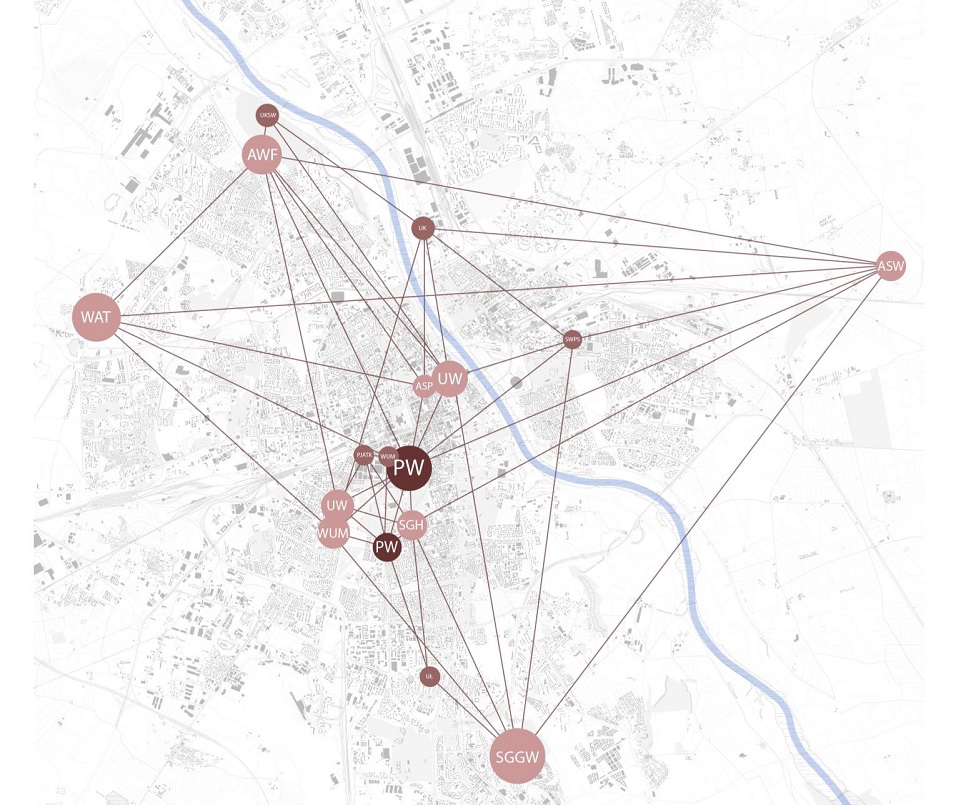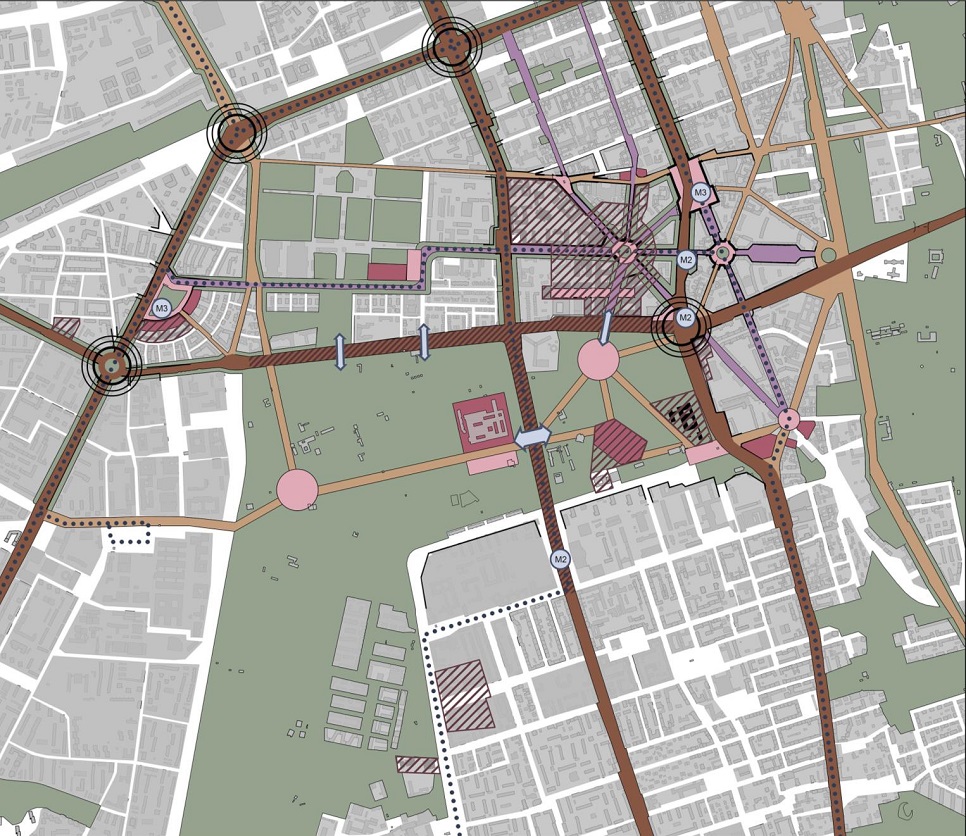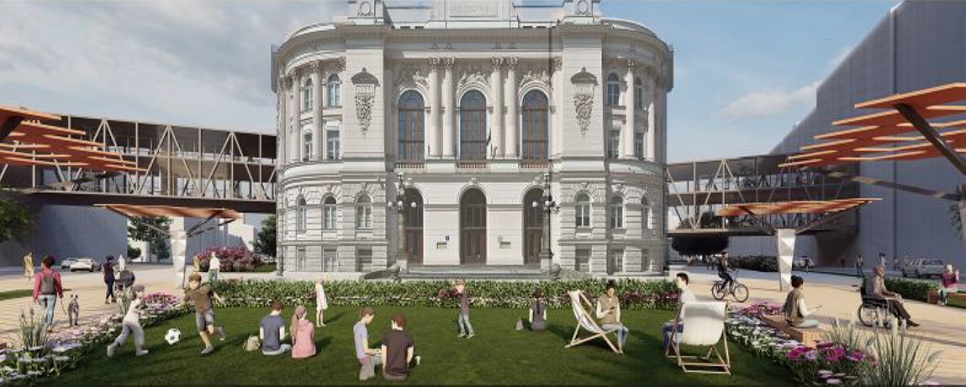What can we do to make the university a good neighbour?

Strategies for the development of the Central Campus of WUT towards the COVID-19 pandemic, authors: students of the AiU2 (Architecture and Urban Planning) Master's specialisation "City as a place to live" of the Faculty of Architecture at WUT. The work was carried out in 2020/2021 under the supervision of A. Cudny and A.J. Filip
What role do campuses play in shaping public spaces and how can they respond to social expectations, particularly in emergency situations? A research team from the Warsaw University of Technology posed such questions and have developed various development concepts for the Central Campus of WUT.
– The aim of our research was to present a vision in which universities should expand their mission by sharing resources with different social groups, and also to show how this can be achieved – says Prof. Krystyna Solarek from the Faculty of Architecture at WUT, the project manager.
The research was conducted by an interdisciplinary team of employees of two WUT faculties: Architecture, and Geodesy and Cartography, as well as of the Institute of Social Studies of the University of Warsaw, the Research and Analysis Department of the WUT Centre for Innovation and Technology Transfer Managment, as well as university students, including doctoral ones.
In a network of connections
The participants of the project tried to address the following questions: how to integrate academic areas into the city's common public space systems, how to respond to neighbourhood deficiencies, how to find innovative solutions that would support the health and safety of people in the face of a crisis such as a pandemic. Due to the social mission assigned to universities, the material and human potential and the key location in the structure of cities, they can become drivers of change, improving the quality of life of the academic community and residents, increasing their safety, supporting health protection and enabling access to necessary areas and services.
– We have examined several Warsaw campuses, both individually, e.g. Warsaw University of Technology or the University of Warsaw, but also in connection with other universities, as well as the complex around the Mokotów Field: WUT, Warsaw Medical University, Warsaw School of Economics, University of Warsaw – explains Prof. Krystyna Solarek.
The team began by analyzing examples of correlations between campuses and the spaces of cities in Europe and around the world. When designating the areas for research, they also tried to refer to the areas surrounding the campuses within the range of approx. 500 m from individual campuses. When it turned out that they are connected with other universities, the spatial scope of analyzes was broadened.
– In spatial research, over time we began to focus on green areas. We analyzed the macro scale, the scale of connections of individual campuses with greenery in Warsaw. Our University does not have many such areas. In the vicinity, there is the Mokotow Field, but separated by a significant spatial barrier from the campus, and from residential areas that are very poor in greenery and recreation areas – says Prof. Krystyna Solarek.
There is potential
Researchers have created a tool to assess the compensatory capacities of campuses, balancing the deficiencies of green areas and open areas in the vicinity. A theoretical model was also developed, which allows to calculate the deficiencies and potentials of the area, when we have appropriate data – including the buit-up area and the heights of buildings, and above all – the number of residents.
– Our analyses show that, especially in the WUT Central Campus, providing residents with some green areas, some open areas would lead to a significant improvement in the indicators for residential areas. This is a serious challenge – emphasizes Prof. Krystyna Solarek.
Another part of the research concerned checking what social and spatial potential various Warsaw universities have. – The potential of the University of Technology is huge, although when it comes to spatial management and responding to various pro-environmental challenges, this area needs to be significantly improved – says Prof. Krystyna Solarek.
Open Campus
In particular, the team devoted a lot of analysis to exploring the possibilities of the development of our University. – We performed experiments involving various approaches to proposing theoretical strategies for the development of the WUT campus in the area of Śródmieście and Mokotów. The conclusion was that during the pandemic, the most important thing would be, despite concerns about the security of property, to adopt the idea of an open campus, including it in the spatial structure of the city – emphasizes Prof. Krystyna Solarek.
The open campus is an idea resulting from the social responsibility of the University, contemporary trends in urban development, as well as deficiencies in the development of the neighbourhood of the University of Technology and the campus itself. It responds to new social expectations as to how to develop areas open to new forms of work, learning and spending free time. Some of these changes resulted from the Covid-19 pandemic, while others have been observed for several years.
– The conducted work showed the need to deepen the performed social research, which is still being carried out at the moment, but all other results lead us into thinking about the campus, which we called "open" in the broad sense of the word – explains Prof. Krystyna Solarek. – It means a campus well connected with public spaces of the city through streets, pedestrian routes, greenery, buildings of high cultural value and various means of transport. It is also a campus that integrates the academic community and their neighbours – residents, employees and users of other areas and facilities, offers interesting spaces, services and activities for different age groups, as well as green areas, all interrelated – she adds.
By excluding car traffic from some areas of the campus, green areas would be recovered, aimed at improving the quality of learning and work at the Technical University, and also the quality of life of the Downtown inhabitants. In this way, the campus would be an inclusive space, thus involving various users in the cohesive life of the University and the city.
In order to implement such an idea, many steps should be taken in cooperation with local government authorities (macro-scale activities). The most important of them is the construction of a footbridge or another crossing connecting the Central Campus with the Mokotów Field, and further – with the Southern Campus, greening of the streets surrounding the buildings of the Warsaw University of Technology, and even a complete reconstruction of some of them.
– It would be useful to introduce squares with the function of nodal spaces, integrating users, emphasizing viewing axes, removing some spatial barriers or giving up some fences. It would probably be necessary to change the planning documents enabling some new investments – enumerates Prof. Krystyna Solarek.
On the scale of the campus itself (called the micro scale), it would be necessary to implement or modernise several buildings, create recreation, meeting and communication areas, use new types of urban greenery, introduce attractive elements of small architecture.
- We presented the initial concepts of transforming the spatial structure of the campus and its surroundings – both on a macro and micro scale. I believe that they may inspire the authorities of the University in the future. We included students of the Faculty of Architecture in the development phase of these projects as part of the master's specialty classes – says Prof. Krystyna Solarek. – We would like to present various visions of the development of the campus prepared by us and the students in the form of a monograph, we are also planning an exhibition at the Warsaw University of Technology to launch a discussion on how the campus could and should change in times of crises. The latest refugee crisis may be another element that should be taken into account – she emphasizes.
The participants of the project: Prof. Krystyna Solarek, PhD, Eng. Arch. – the project manager, Anna Cudny, PhD, Eng. Arch., Artur Filip, PhD, Eng. Arch., Tomasz Majda, M.Sc. Eng., Justyna Zdunek-Wielgołaska, PhD, Eng. Arch., Anna Jachimowicz, M.Sc. Eng., Judyta Wesołowska M.Sc. Eng. (Faculty of Architecture, WUT), Katarzyna Osińska-Skotak, PhD, D.Sc., Professor (Assistant) Krzysztof Bakuła, PhD, Eng., Sylwia Krzysztofowicz, M.Sc. Eng. (Faculty of Geodesy and Cartography, WUT), Anna Domaradzka, PhD (Institute of Social Studies of the University of Warsaw), Magdalena Matysiak, M.A. Ewa Bichta, M.A., Aleksandra Wycis-Cisek, PhD (Centre for Innovation and Technology Transfer Management of the University of Warsaw), Olga Czeranowska-Panufnik, M.Sc. Eng. Arch., Władysława Kijewska M.Sc. Eng. Arch. (Doctoral School No. 5 WUT), as well as students of the Faculty of Architecture at WUT, Justyna Buczkowska, BEng. Arch., and Katarzyna Szmołda, BEng. Arch.,
Project "New social roles of campuses during the pandemic. The experimental space of interaction at the Warsaw University of Technology was financed under the program "Excellence Initiative - Research University" implemented in the WUT. It was among the winners of the "IDUB against COVID-19" competition.










